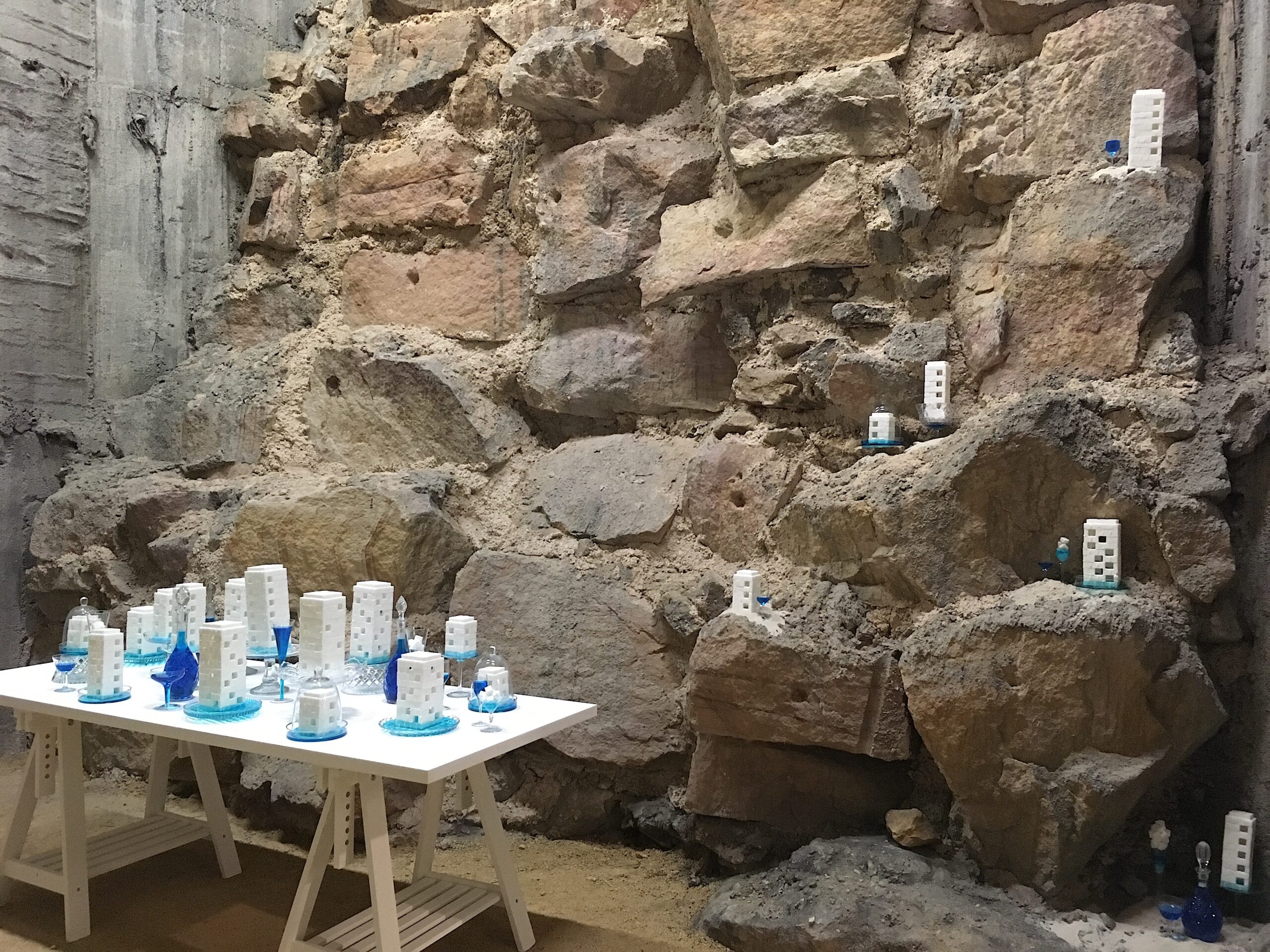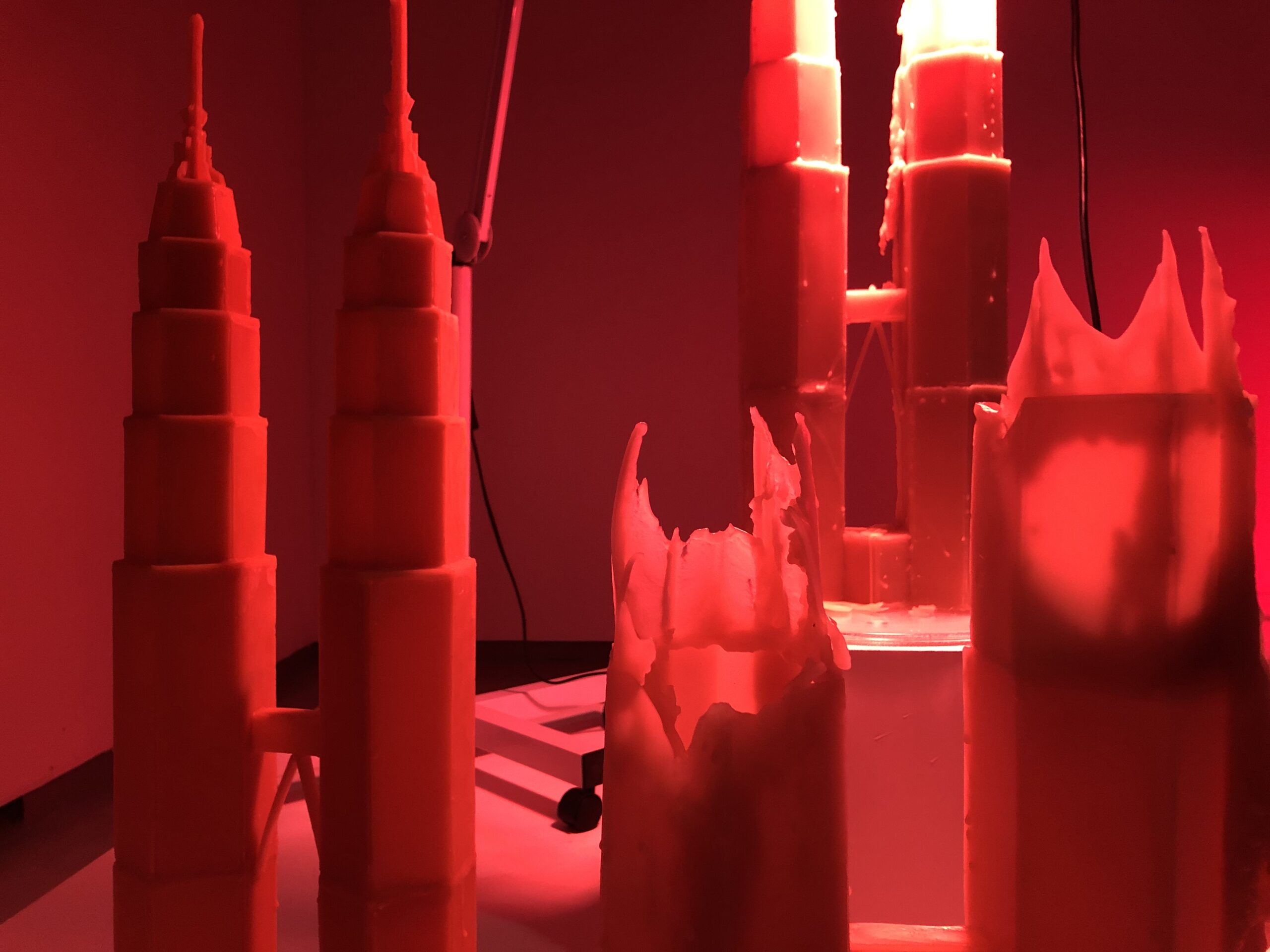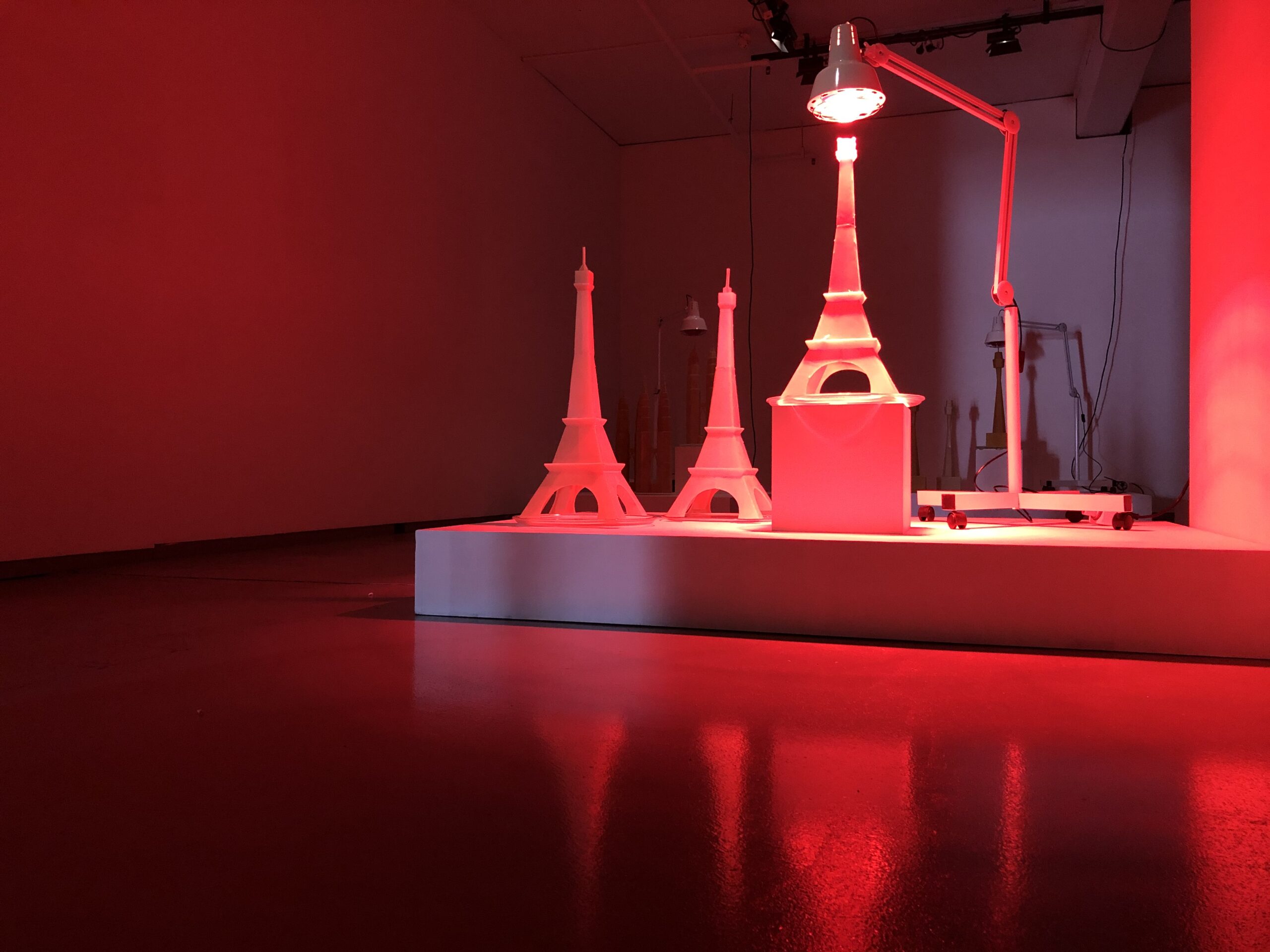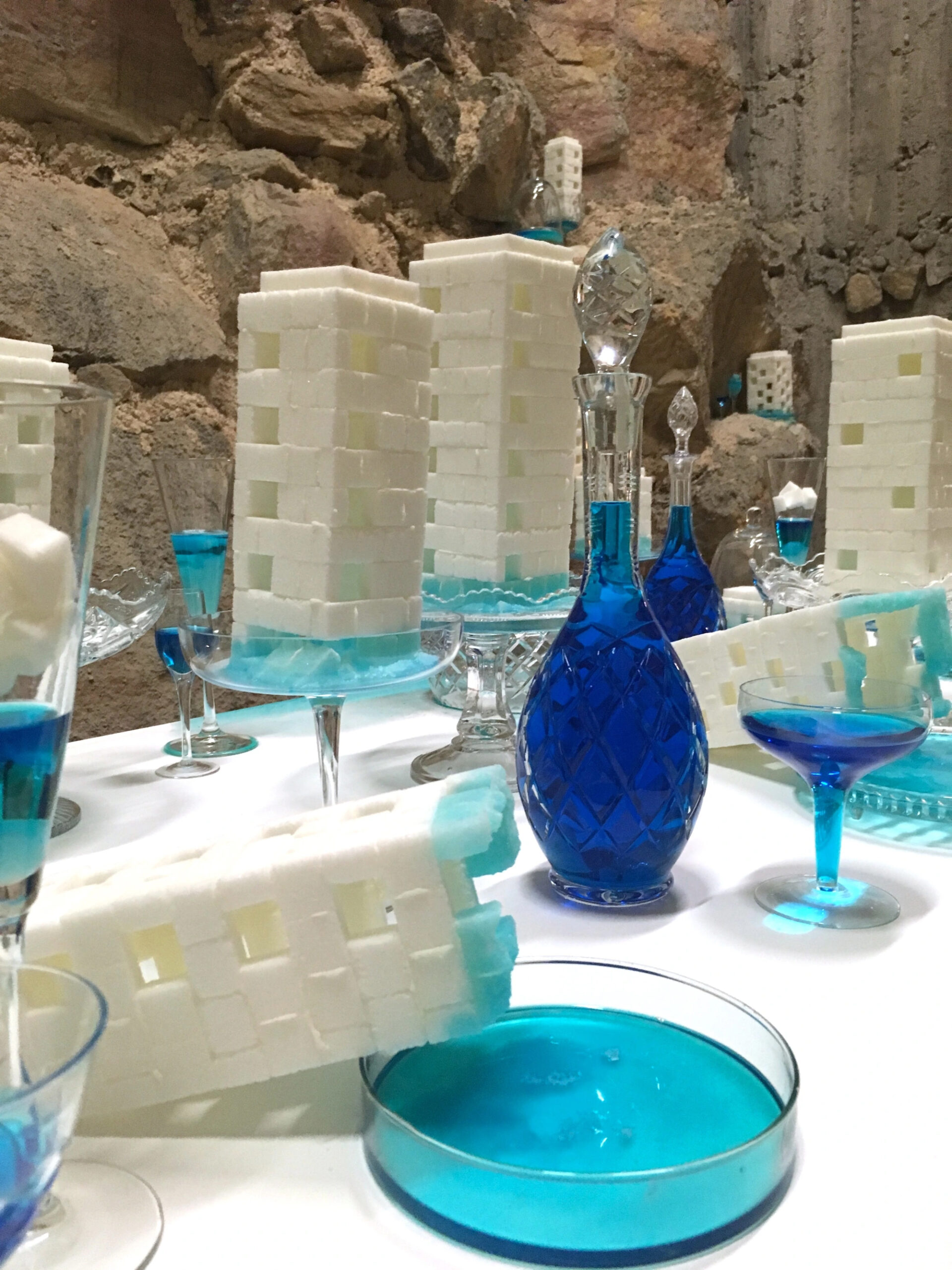Fiddling while Rome burns
Written by Tracey Clement
Originally published in 2021

Tracey Clement, Banquet, installed in at the Coal Loader Centre for Sustainability as a finalist in the North Sydney Art Prize, 2-17 March 2019, sugar, glass, laundry soap, dimensions variable.
Turquoise blue liquid seeps into the foundations of brutalist skyscrapers made from glittering cubes of sugar. Drawn upwards by osmosis, this liquid undermines the foundations of a miniature city. White buildings balanced on fancy cut-glass are stained pale blue as the sugar dissolves. They list slowly, then tumble quickly; crashing into each other, spilling liquid, breaking glass. Laid waste the city looks like a post-apocalyptic tourist brochure; crumbling white architecture languishes in impossibly bright blue lagoons.
Elsewhere multiple beeswax models of the Eifel Tower, Sydney Tower, the Empire State Building, Petronas Towers, and Big Ben succumb to relentless artificial heat. The room glows an eerie and dangerous red as these iconic towers glisten then melt. Molten wax fills up internal reservoirs until the tower walls can take no more. Finding the weakest point it pours out, cascades down the sides of the buildings and solidifies in arrested pools. The sweet smell of honey fills the air as these symbols of human achievement are inexorably obliterated.

Tracey Clement, Soon it would be too hot 2021 (detail: Petronas Towers), beeswax, microwave plates, heat lamps, dimensions variable.
My artworks described above – Banquet, 2019, and Soon it would be too hot, 2021 – present sublime images in the true sense of the word; they are both beautiful and terrifying (if I do say so myself). But beauty (even scary beauty) is not the point. I made them – deliberately, painstakingly, laboriously. And I destroyed them. This is the point.
The catastrophes in these miniature cites mimic rising oceans and increasing temperatures, accelerated to the point of extreme visibility. Disasters in models of imaginary cities, like model cities themselves, don’t just happen. They are a wilful act, a human-made phenomenon. Just like the climate crisis.
Anthropogenic climate change is an ongoing disaster of our own making. As consumers, we are all culpable. Every single one of us. In fact, even when we don’t do anything we are part of the problem. As feminist philosopher of ethics Claudia Card (1940-2015) made clear in her book, The Atrocity Paradigm, we can perpetrate evil acts even when we do nothing. “To be culpable,” she wrote, “we ought to have acted differently.” (1) In other words, we can all be held to account for both our actions and our inactions.
Making art is my attempt at action. I’m trying to start conversations about the climate crisis in a way that doesn’t paralyse people with doom-laden facts. I’m trying do something. But is it the right thing to do??
I don’t have solar panels, or pay extra for renewable power, so I’m burning coal every time I flip on my lights or use my computer. And even though I don’t own a car, every time I get a delivery from an online purchase it has travelled at least part of the way in a fossil fuel burning vehicle. This applies even when I make artworks from mostly recycled materials.

Tracey Clement, Soon it would be too hot 2021 (detail: Eiffel Towers), beeswax, microwave plates, heat lamps, dimensions variable.
Everything I make burns carbon. By trying to discuss the problem, I’m contributing to the problem. I’m consuming while critiquing the toxic effects of consumerism. It’s ironic, a troubling conundrum that many artists wrestle with.
In an article titled ‘Art in the time of the burning’ (published by Artlink magazine in response to the cataclysmic bushfires of 2019-2020) artist Ian Milliss wrote, “If manufacturing content for the art market provides you with an income you may as well continue, given the short time left. But since art in that sense is a luxury form of consumerism, a major cause of our problems, you should probably be seriously considering whether your time would be better spent instead doing things that might help save us.” (2)
Have we reached the point where making art is actually pointless? Is being an artist a case of ‘fiddling while Rome burns?’
According to dictionary.com ‘to fiddle while Rome burns’ is to “do something trivial and irresponsible in the midst of an emergency.” (3) The phrase was coined, so the story goes, to highlight Emperor Nero’s gross negligence as his city was destroyed by fire in July 64 CE. And it was levelled at the Prime Minister when he jetted off to Hawaii in late 2019, while Australia was literally going up in smoke. (4)
I’ve been thinking a lot about this saying since that horrific summer. I think this phrase is insidious, and it’s time it was challenged. Not because I think our elected leaders (or for that matter, mega wealthy corporations who arguably have even more power) should be let off the hook. Quite the opposite. What I object to in the phrase ‘fiddling while Rome burns’ is its engrained denigration of the arts.

Tracey Clement, Banquet, 2019 (detail), sugar, glass, laundry soap, dimensions variable.
Why, for example, wasn’t Nero accused of clipping his toenails, or getting a haircut, or watching the cricket instead of dealing with the disaster at hand? And why isn’t fiddling (or making any kind of music, or writing, or painting etc) seen as a form of taking action? Why do we, as a society, collude with this notion that doing something creative in the face of catastrophe is inherently trivial?
I know I am part of the problem. But am I irresponsible? I hope not. I don’t know if making art in the midst of a crisis is this the best thing to do, but it is the thing I can do.
Art is a language that conveys the ineffable, it can say what can only be felt. We are in terrible, terrifying times. And if bearing witness by making this terror manifest in three-dimensions while also transforming it into fleeting glimpses of beauty is fiddling while Rome burns, then guilty as charged. I’m fiddling, too bloody right, I am.
Tracey Clement
Tracey Clement is an artist and arts writer currently based in Sydney. She has been making sculptural installations in the form of model cites, both post-apocalyptic and utopian, since 2014.
Notes
- Card, Claudia. The Atrocity Paradigm: A Theory of Evil. Oxford: Oxford University Press, 2002, page 18.
- Ian Milliss, ‘Art in the time of the burning,’ Artlink, January 2020, https://www.artlink.com.au/articles/4815/art-in-the-time-of-the-burning/. Accessed 1 May 2021.
- dictionary.com, https://www.dictionary.com/browse/fiddle-while-rome-burns. Accessed 1 May 2021.
- Peter Hartcher, ‘Our leaders fiddle while the country burns,’ The Sydney Morning Herald, 16 November 2019, https://www.smh.com.au/politics/federal/our-leaders-fiddle-while-the-country-burns-20191115-p53b3q.html. Accessed 1 May 2021.
TC LINKS
Banquet: https://traceyclement.com/category/banquet/
Soon it would be too hot: https://traceyclement.com/2021/02/28/soon-it-would-be-too-hot-2/
Soon it would be too hot time-laspe videos:
Big Ben https://youtu.be/4wb6Z7tlUdQ
Eiffel Tower https://youtu.be/nZ1xQ_ipchY
Instal https://youtu.be/jJpbGbyJ1cE
READ more
- June 2025: BECOMING JULIE VISIBLE and THE CAROUSEL OF INVISIBILITY by Steven Cavanagh
- June 2025: Finalists Announced for the 2025 Mullins Conceptual Photography Prize
The READ Archives
- May 2022: Q&A with the Winner of the 2021 Mullins Conceptual Photography Prize, Ian Skinner
- July 2022: On Conceptual Photography by Alex Wisser
- September 2022: Artist’s creative spirit took flight in Upper Hunter by Laurie Sullivan
- December 2022: On Art Prizes by Dr John Barnes
- September 2023: A Field Guide to Abstraction in the Muswellbrook Collections by Brad Franks
- August 2024: LiddellWORKS Opening, Muswellbrook Regional Arts Centre, by Rob Cooper

